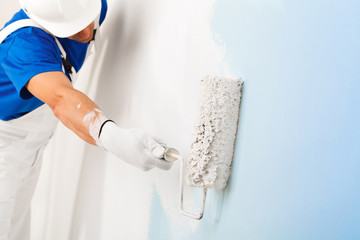From hosting a family dinner to completing a mile-high stack of paperwork, your indoor spaces are where you spend most of your time. A fresh coat of paint can make a room feel brand new and set the tone for how you use your space.

A professional painting company like M&J Painting can help you achieve a polished look that’s durable and high-performing. Learn more about what to expect when hiring an interior painter.
Using different wall painting techniques, professionals can transform rooms with new colors and fresh styles. Some popular options include ombre, striping, and stenciling. Ombre is a color blending technique that uses several layers of paint to create a smooth transition from light to dark. To achieve this effect, a painter will begin by painting the lighter color on the entire wall as the base coat. Then, they will apply a darker color over the top of the lighter layer and carefully blend it in with the paintbrush. Then they will repeat this process with the next darker shade until the entire wall is a seamless gradient of colors.
Another popular option is to use accent walls with bolder shades. This technique allows homeowners to change the look of a room without having to purchase new furniture or other decorative items. Changing the color of a room can also be an effective way to invigorate the home and raise its value. Professional painters will provide a thorough cleaning and preparation of the walls before painting, as well as clean up and dispose of materials at the end of the job.
When hiring a painting service, it’s essential to find out how the contractor charges for their work. Some offer hourly rates while others have fixed project pricing. Fixed pricing can help eliminate confusion and give the client peace of mind that they won’t be overcharged for work done poorly or rushed.
A painting contractor should be licensed and insured, as well as have the proper tools for the job. They should also be able to answer any questions you may have about their work and the painting process. If they are unable to do so, it’s a good idea to find a different company.
Before the painting begins, a good contractor should thoroughly clean the walls and make sure all surfaces are free of dirt, dust, and other debris. They should also remove hardware such as window locks and lifts, doorknobs, and doorknob strikes. They will then cover anything that cannot be removed with plastic sheeting and clear a pathway around the room that’s at least 3 feet wide. They should also caulk any gaps or seams to create a smooth, uniform appearance and prevent moisture infiltration.
Painting Materials
Professional painters know how to use the right painting materials to get the best results. They may also offer a guarantee or warranty on their work. This is a sign that they take their work seriously and are committed to ensuring their clients’ satisfaction. Aside from the obvious brushes and rollers, they will need masking supplies to protect trim or walls you don’t want painted as well as a drop cloth to prevent spills and drips. They will also need to move furniture if it is in the way of their work or is too close to the walls. They might even need to remove any pictures, clocks or other wall hangings.
Painter’s tape is essential to the success of any painting project because it helps ensure precise lines and protects surfaces from accidental paint drips or spots. It is available in a variety of colors and sizes to fit different jobs, such as a thin plastic film that clings to surfaces with static electricity, or a woven canvas that’s more durable but slightly more expensive than a regular drop cloth.
A canvas drop cloth is ideal for preserving floors and other surfaces because it’s less slippery than a plastic version and will absorb paint when it spills. It’s also reusable, making it more cost-effective than disposable drop cloths.
Other important tools include a screwdriver, which can be used to remove hardware like switch plates and door hinges before painting. Hole filler can be dabbed into small holes to repair imperfections in drywall. Finally, a high-quality ladder that’s rated to support the weight of the painters is a must to help them reach higher places.
You will need various types of paint, including flat or matte, eggshell, satin, semi-gloss and glossy. The gross level, or sheen, of each type reflects light differently and can impact the look of the room. A low-gross finish is more matte and dull, while a high-gloss finish is the most reflective and shines more. For most rooms, a matte finish will be appropriate, but you should consult with your professional painting service to discuss the ideal sheen for each room.
Choosing the Right Colors
Color is a powerful interior design element. It can transform a room’s atmosphere and create a space that feels more inviting or energetic. There are thousands of colors to choose from, and selecting the right one is an important decision that requires careful consideration. Choosing the right paint color doesn’t just consider your personal preferences; it also takes into account the existing furniture, wood detailing, carpets and other accessories in the room. There are three key color schemes that work well together: a monochromatic scheme (using shades of the same color), a complementary scheme (colors that sit opposite each other on the color wheel) and a contrasting scheme (the most vibrant).
The choice of paint color is especially important for commercial interior painting projects. Whether you own a coffee shop or a restaurant, you want to create an atmosphere that suits your business’s goals and the types of customers you serve. For example, darker colors are often more appropriate for fine dining establishments than lighter, brighter shades.
It’s always a good idea to take the time to collect color samples and examine them in different lighting conditions before making a final decision. It’s also helpful to consult with a professional interior painter for guidance. A professional can suggest color combinations that you may not have considered and help ensure that your selections will be successful in achieving the desired outcome.
Color consultations are a great way to get a sense of how a color will look when it’s applied on your walls and ceilings. You can also use online resources to find inspiration for interior paint colors and schemes.
Once the color selection process is complete, you will receive a written proposal that includes the selected colors along with any other details and specifications for the project. The contract will also include a detailed estimate of the project’s scope and cost.
Once the proposal is approved, CPS will schedule your project to begin. We will work diligently to ensure that your painting project is completed on time and within budget. Our goal is to exceed your expectations and provide you with an exceptional painting experience.
Getting Started
Whether you’re selling your home or simply want to spruce up your space, a fresh coat of paint can make all the difference. It can set expectations, improve visual appeal, prevent wear and tear, and bring a property in line with current market trends. Interior painting also tends to have one of the highest returns on investment compared to other types of home improvement projects.
Depending on the size of your project, you might need to hire additional workers or purchase equipment. If you need to buy supplies, consider establishing relationships with your local suppliers. This can mean getting referrals and securing deals on items like paint and brushes.
If you’re planning on running your own painting business, it’s important to prepare a business plan to guide you. This will help you avoid mistakes, remain organized, and get the job done right. You can find free templates online or work with a professional writer to create a business plan for you.
Once you’re ready to start working, be sure to register your business, obtain a license, and establish a bank account. You may also need to secure insurance for your company to protect yourself and others in the event of an accident or disaster. You’ll also want to determine which legal structure best suits your needs: a sole proprietorship, a partnership, or a corporation.
When you begin your painting projects, it’s common to identify and complete repairs before starting a new paint job. This can include drywall repair, wall patching, wood trim replacement, and scraping and sanding existing paint before applying a primer or finish. It’s essential to address these issues before beginning any painting work, as they can impact the appearance and longevity of the final product.
If you’re planning to paint in someone else’s home, be sure to cover furniture with plastic sheets or move it out of the way. You should also remove pictures, clocks, mirrors, and other wall hangings before the painters arrive. They should also remove any light fixtures or electrical outlets that need to be covered or removed.




 Some of the most common pre-painting tasks include cleaning the area, moving furniture, and removing flammable material. A professional painting company can help if you need help withe what to do. They will provide you with everything from drop cloths to rollers and brushes. The painting professionals
Some of the most common pre-painting tasks include cleaning the area, moving furniture, and removing flammable material. A professional painting company can help if you need help withe what to do. They will provide you with everything from drop cloths to rollers and brushes. The painting professionals